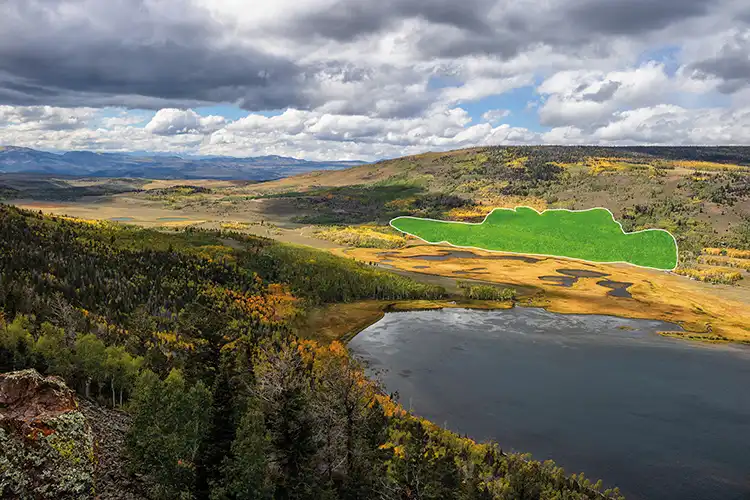
Pando, a single quaking aspen in Utah covering 43 hectares, could be between 16,000 and 81,000 years old. New threats mean the world’s largest tree is now in decline
By
Tucked into the valleys of Fish Lake, Utah, lies a near-mythical stand of trees. Each trunk, though appearing distinct, makes up the same individual. ‘Pando’ – which translates to ‘I spread’ in Latin – covers 43 hectares and weighs more than 6,000 tonnes. This hulking ‘clonal’ stand of aspen is the largest living single organism on Earth, and although it has survived for millennia, today it’s under unprecedented pressure.
Pando is formed of 47,000 genetically identical aspen stems that emerged from a single seed, likely back when the last ice sheets had receded. Paul Rogers, director of the Western Aspen Alliance, describes it as ‘a forest of one tree. We can think of each tree really as a branch.’
Recent DNA analysis of some 500 samples taken from Pando and neighbouring clones suggests that the tree is between 16,000 and 80,000 years old, making it one of the oldest living organisms in the world (although this research is yet to be peer reviewed). Over the past few decades, mature trees within the stand have begun to die rapidly, which, according to Rogers, isn’t unusual. ‘What is unusual is the lack of younger generations coming through.’
To understand Pando’s changing demography, it’s important to first understand its reproductive strategy. ‘Aspen is different from most other trees – their root systems are completely interconnected, and this allows them to reproduce vegetatively, or clonally,’ explains Darren McAvoy, a researcher at Utah State University. Clonality allows aspen to live far longer than a single tree would. In response to environmental stresses such as fi re or parasites, identical trees release chemical compounds to the root system, which trigger the release of new ‘suckers’ – young, nutrient-rich shoots that quickly grow through the soil to replace the dying trees.

‘This has worked for a very long time,’ adds Rogers. ‘But in the modern era, we’ve overwhelmed the system with browsers.’ Today, mule deer and elk populations in Utah have risen sharply due to the depletion of wolves, bears and pumas, and Utah gamekeepers deliberately maintain high deer and elk densities for hunters’ satisfaction.
‘There’s no pressure on the deer and elk, and due to that grazing pressure, Pando is shifting towards an elderly tree community,’ says Richard Walton, a plant biologist at Newcastle University. ‘As younger suckers are browsed, there are no longer infant, teenage or young adult aspen clones coming through.’
Enjoying this story? Check out our related reads…
Beneath the ground, too, the health of the root system is depleting. ‘All of Pando’s energy is stored in the root system underground,’ Rogers explains. ‘Each leaf is like a solar panel feeding energy to the underground system. If old trees are not replaced as they die, there’s less carbohydrate flowing into the root system, meaning it has less energy to respond to environmental stress.’
Fences are an immediate intervention, but ‘they’re a band-aid,’ says Rogers. ‘They’re expensive and not viable in the long-term. We need to save the patient right now and that means quick interventions. Really, what’s going on inside the fences is just as artificial as outside.’

Clonal aspen, Rogers says, should be constantly reproducing – a steady turnover of life and death. ‘With fencing you get a wave of growth, which actually makes the trees susceptible to disease. Last year, 90 per cent of Pando’s stems inside the fences were infected with black canker.’ As the health of the root system depletes, a single virulent disease could completely wipe Pando out.
The longer-term solution is to restore the processes that have moulded Pando’s reproductive strategy. ‘Too often, our conservation focus is on species composition: “We need 322 of this, 43 of that.” But we need to be more focused on restoring processes – that’s the long-term solution for Pando, and for forests worldwide. These include the predator–prey, fire and disturbance dynamics that human activity has shift ed,’ says Rogers.
Pando has become symbolic for many who understand its biology. ‘There’s the obvious conservation value,’ says Walton. ‘But beyond that, Pando is a canary in the coalmine – an indicator of forest health worldwide. If we can’t take care of this prized individual, how are we going to take care of the rest? Our impact on ecosystems is all playing out within 43 hectares.’




